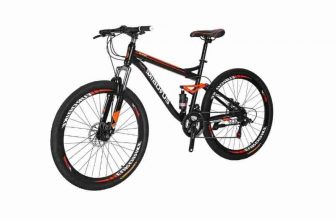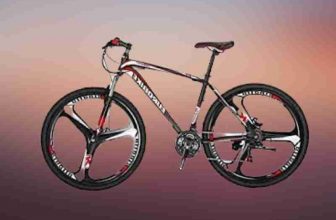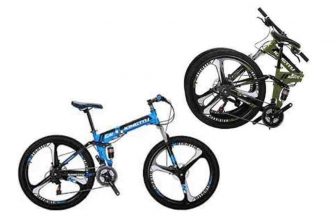
Compared to a road bike, a mountain bike is built for off-road use and can handle a wider range of terrain. Many riders appreciate how comfortable mountain bikes are, especially because they are always ridden upright. Mountain bikes, on the other hand, are typically slower than road bikes.
Moreover, the decrease in speed depends on various factors, including the type of mountain bike tire, the terrain, and the rider’s weight and riding style.
However, mountain bike tires generally tend to be wider and have more tread than traditional road bike tires, leading to a slight decrease in speed.
While narrower tires are faster but may have less traction, they can increase acceleration.
So, Yes, mountain bike tires are more likely to cause a rider to ride slower than road bike tires. This is because they are thicker, which means that a greater portion of the tire’s surface makes contact with the ground.
While larger tires are slower, they provide additional protection against bumps and divots, keeping the rider comfortable.
How Much Slower Is A Mountain Bike On The Road?
If you ride a mountain bike on the road, you will likely travel 15 to 20% slower than if you rode a road bike. That is, assuming the rider exerts the same effort while pedaling. When riders switch to mountain bike tires, they typically notice an increase in 2 or 3 mph speed.
The fact that mountain bikes have knobs is one of the primary reasons they are so slow on the road. The grip is critical for safety when riding a bike off-road on trails. That is why mountain bike tires are equipped with knobs. This is fantastic on trails, but it can significantly slow a person down on the road.
Suppose you want to accelerate your mountain bike on the road. In that case, we recommend using hybrid mountain bike tires such as these. Kendra city slick mountain tires are engineered for increased speed and low rolling resistance, resulting in a more enjoyable mountain biking experience.
These knobs absorb the rider’s pedal-power on the road; the rider will have to double their effort to keep up with their road-biking buddies.
Newer models of mountain bikes have a 1X11 gear system, contributing to their slower road speed than road bikes. This gear system is incredible and significantly lighter for riders on the trails. It’s significantly easier to change gears while off-road biking than previous models. However, this gear system is not intended for highway use.
11-speed bikes, as wonderful as they are, were not meant to be ridden on the street. Even though they improve trail riding, they cannot keep up with traffic on the road. Road bike tires can’t keep up with the gears on these bikes.
How To Make a Mountain Bike Faster on the Road?
Tires
The first step is to replace the tires with thinner ones. This reduces rolling resistance and lightens the bike. Ascertain that the tires are slick and free of knobs. This will assist you in rolling faster and gaining momentum.
Suspension
Remove any suspension from the front and rear tires. Additionally, you can lock out your suspension or adjust its stiffness or rigidity. Now, you will not lose any pedal power due to shock absorption. Because the pavement is flat and smooth, no suspension is required.
Pedals
If you are currently using flat pedals, switch to clipless pedals. You will push down first and then pull up to complete the rotation when you pedal now. Throughout the pedal stroke, you apply force, which increases your speed.
Handlebars
Replace your current handlebars with more narrow ones. Then adjust your handlebars to the lowest position possible. This positions your body in a more aerodynamic position. Your elbows, as well as your head and shoulders, can be tucked in. This reduces wind resistance and speeds you up.
Fork
Use a rigid fork instead of a mountain bike fork, and this is to ensure that you can absorb the impact. With travel bouncing, you will lose speed, and it is especially true if you stand on the pedals to increase your speed. A rigid fork will assist you in propelling your pedaling power forward.
Chainring
You can switch to a single chainring if you currently have three chainrings. This will lighten the load on your mountain bike, making it more maneuverable on the road. Weight savings of up to 300 grams are possible. It matters more on the road than on the trail, where weight is absorbed.
Optimize Tire Pressure
Another critical factor in maximizing your riding efficiency is tire pressure.
When a tire is underinflated, it spreads out and creates more contact surface area with the ground. While this is beneficial for increasing traction, it can also cause you to lose speed.
The trail terrain you ride, your weight, and your riding style can all affect the tire pressure that is optimal for you.
A pressure of between 25 and 35 psi is a good starting point. When performing your tests, experiment with pressure differences of as little as one psi to truly fine-tune the optimal setting.
Always keep a decent mini or floor pump on hand to ensure that your tires are properly inflated before each ride.
Lubricate drivetrain
A properly lubricated drivetrain will operate more efficiently. Lubricants enable parts to move past one another with less friction. Each joule of energy saved from the friction is transferred to the wheels, allowing you to travel further.
Along with improving the drivetrain’s efficiency, you’ll also be sparing it from some wear and tear. Friction is your adversary when it comes to both speed and the life of your drivetrain! Maintain adequate lubrication on your chain, chainring, rear cassette, and derailleurs to ensure smooth operation.
They accumulate less gunk than wet lubes and allow the drivetrain to operate more efficiently.
Products manufactured by Tri-Flow Get You Movin’ with triple action cleaning, protection, and lubrication for optimal performance. This formula combines advanced ingredients with optimal application methods to combat the road’s, trail’s, and track’s greatest adversaries – moisture, corrosion, and metal-to-metal friction.
Optimize shifting
Along with a clean and well-oiled chain, you’ll want to check that your derailleur(s) and cable tension are configured properly to ensure smooth shifting. Because many modern mountain bikes feature single-front chainrings, many of us are only concerned with adjusting the rear derailleur.
Smooth-shifting on a bike allows for more efficient riding and power delivery. You won’t have to worry as much about a chain-breaking, as it can easily shift between your highest and lowest gears while you’re out on the road.
Using the H and L limit screws on the derailleur to make adjustments. As you might expect, “H” stands for high, and “L” stands for low.
After you’ve adjusted the limit screws, you’ll need to adjust the cable tension with the barrel adjusters. A properly tensioned cable allows the chain to move smoothly up and down the gears with quick shifts. When the chain struggles to move up or down during shifts, you’ll know it’s not right.
Align brakes
Mountain bike brake alignment is the process of adjusting the position of the brake pads so that they make contact with the braking surface of the wheel rim in the correct place.
The aim is to have both pads touching the rim simultaneously, with as little space as possible between them. This maximizes the friction between the brake pad and rim, improving braking power.
When braking, it is important that both brakes be applied evenly so that the bicycle does not skid. To ensure equal braking, it is important to align the brakes properly.
Avoid making drastic changes all at once. If the current rotor is damaged, it may need to be replaced.
Improve saddle position
Adjusting your saddle to the optimal height and position can significantly improve your pedaling efficiency. While it may appear insignificant, a few centimeters difference can significantly affect.
This should ensure that when you pedal normally with your normal foot placement, your knee bends slightly at the bottom of your stroke. While many mountain bikers use dropper posts to rapidly lower their seats during long descents, setting the proper top height is critical.
Is It Okay To Ride A Mountain Bike On The Road?
All-terrain bikes, on the other hand, are designed for specific terrains. It is permissible to ride a mountain bike on the road, but you must allow sufficient time to reach your destination. Because mountain bikes are heavier, they are frequently more difficult to pedal on pavement.
Additionally, the thicker tires are significantly slower on the pavement. Road bikes feature narrower tires that easily pick up speed and momentum on the pavement. It takes significantly more effort for the rider to maintain a good average speed on the pavement.
Due to the comfort of the mountain bike, many riders enjoy riding it on the road for fun. Even when riding on the road, riders can maintain their upright position.
What About The Aerodynamics Of Wider Tires?
The wheel with the most contact area with the ground is the tire with the smallest contact area, followed by the least contact area. The less the contact area, the less friction between the tire and the road. This means the tire with the smallest contact area is more efficient than one with a bigger contact area.
How Does Tyre Size Affect Climbing Speed?
There is no such thing as the optimal tire size for any terrain or surface. It depends on how fast you want to go, how much weight you’re carrying, and how the weather is in the area you’re visiting.
However, the wider the tire, the greater the grip, so the larger the tire, the slower you climb.
Are Mountain Bike Tires Slower?
Generally speaking, though, mountain bike tires are designed to provide traction and stability on rugged terrain, often resulting in a slower ride.
Are Mountain Bikes Slow On Pavement?
Mountain bikes are designed for off-road use and may be slower on pavement than traditional ones. This is because mountain bikes typically have wider tires that provide more traction and stability when riding on unpaved surfaces but can be more challenging to pedal on paved roads.
However, some mountain bikes have tires designed for improved performance on pavement. Additionally, many mountain bikers will improve their speed on pavement, such as selecting a lower gear.
What Is A Good Average Speed On A Mountain Bike?
Mountain bikes are designed for exploration rather than competition. These bikes can go up, down, and everywhere in between. The average speed for singletrack mountain biking is approximately 10 mph (16 kph). Riders typically travel at 8 mph when ascending a hill (13 kph). They should maintain a speed of 12 mph while descending (19 kph).
Average speed is affected by the riders’ positions as well. Mountain bikes were created for the rider to be as upright as possible. With this, they’ll have the ability to maintain their balance and stability while out on the trails. As a result of this position’s aerodynamics, it’s more difficult for the rider to get up to speed.
Conclusion
Mountain bike tires are not intended for racing; rather, they are intended to make off-road biking safer and less difficult so that all can enjoy it. Because these tires are not designed like road bike tires, they slow bikers down. More surface contact is possible due to the thicker tires. While this results in a safer ride, it also results in a slower ride.
Some riders prefer mountain bikes for riding in areas where roads aren’t well maintained.






